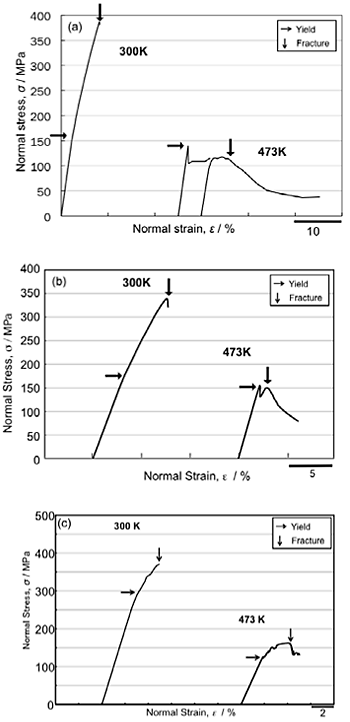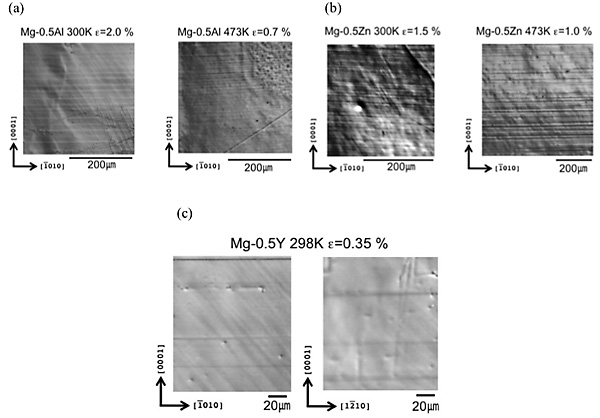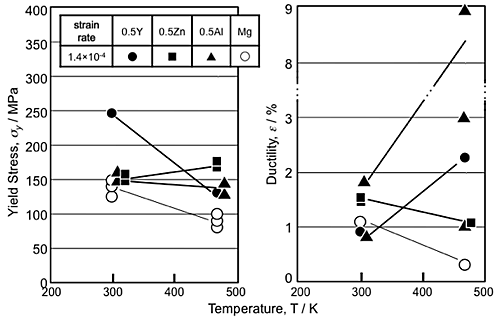Recently, magnesium alloys are being used in structural applications in the automotive filed due to their high specific strength. Many researchers have been reported to modify the formability by controlling their microstructure. In the situation, fundamental understanding about the deformation mechanism of magnesium is important to improve their plasticity. In hcp metals, (0001) basal slip and (1010) prismatic slip are well known as main slip systems, but total number of these independent slip systems is not satisfied the von-Mises criterion. Therefore, another non-basal slip systems must be activated to deform the polycrystalline materials uniformly. To improve plasticity of magnesium, it is necessary to increase the activity of such non-basal slips. The effect of aluminum and zinc addition on deformation behavior in magnesium single crystals was reported. In these cases, critical resolved shear stress (CRSS) due to basal slip increased by aluminum and zinc addition. However, the effect of zinc and aluminum on non-basal slip in magnesium is not well known. Moreover, Mg-Y alloy system exhibits an improved ductility by enhanced activity of non-basal slip. With these viewpoints, the aim of this work is to investigate effect of alloying element, such as Al, Zn and Y, to activity of non-basal slip system by [0001] compression test of alloy single crystals.
Mg-Al, Mg-Zn and Mg-Y alloy single crystals were grown by unidirectional solidification method. From the crystal, rectangle shape compression test specimens with (0001), (1010) and (1210) surfaces were prepared. Size of the specimens were about 3 mm ![]() 3 mm
3 mm ![]() 6 mm and the compression axis was [0001]. Compositions of the specimen were Mg-0.5at%Al (refers as 0.5Al), Mg-0.t%Zn (0.5Zn) and Mg-0.5at%Y (0.5Y). Testing temperature were 300K and 473K, and nominal strain rate was 1.4
6 mm and the compression axis was [0001]. Compositions of the specimen were Mg-0.5at%Al (refers as 0.5Al), Mg-0.t%Zn (0.5Zn) and Mg-0.5at%Y (0.5Y). Testing temperature were 300K and 473K, and nominal strain rate was 1.4![]() 10-4/s.
10-4/s.
Figure 1 shows typical stress-strain curves of 0.5Al, 0.5Zn and 0.5Y, respectively. At 298K, all alloy single crystals showed similar deformation behavior, such as quickly strain hardening after yielding and fracture at about 380MPa. At 473K, yield stress of Mg-Al alloys decreased and the plastic strain increased. In the case of 0.5Zn, yield stress of the alloy also decreased and the strain was same as at 300K. In the case of 0.5Y, while yield stress of the alloy also decreased as same as 0.5Al and 0.5Zn, 0.5Y alloy did not show yield drop phenomena.
Figure 2 shows the specimen surfaces. In all alloys, fine slip lines inclined about 54 degrees to basal trace were observed on (1210) plane at both temperatures. On (1010) surface, slip lines inclined about 39 degrees were often observed. This result shows that all alloy single crystals were yielded by {1122}< 1123> secondary pyramidal slip.
Figure 3 shows temperature dependence of the yield stress and the ductility. Both alloys show strong negative temperature dependence of the yield stress. The yield stresses of [0001] compression were increased by aluminum, zinc and yttrium addition. At 300K, alloying effects of yttrium was much higher than other alloy element. In contrast, at 473K, the yield stress of 0.5Y decreased with increasing temperature, and the yield stress of 0.5Zn was highest. Ductility of 0.5Y and 0.5 Al increased at 473K while 0.5Zn decreased. In the case of pure magnesium, as indicated in the figure, the ductility decreases with increasing temperature. Pure magnesium single crystal fractures by cracking caused from {1011}-{1012} double twin at higher temperature. As shown in the figure, 0.5Y and 0.5Al showed high ductility compare to the 0.5Zn and pure magnesium, it seems that adding yttrium and aluminum affect to nucleation of the double twin.


